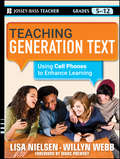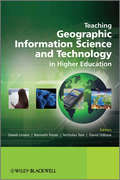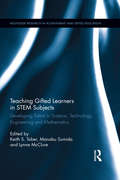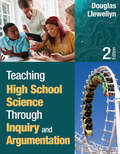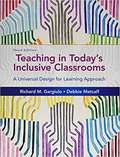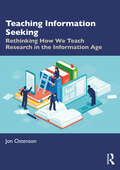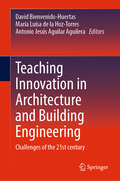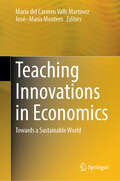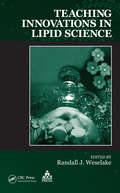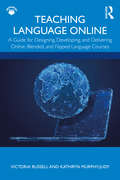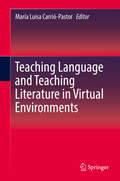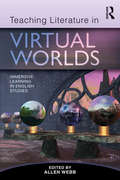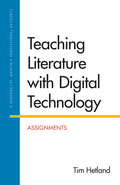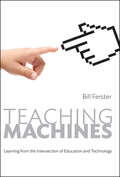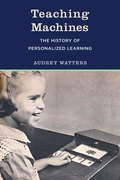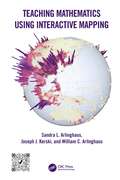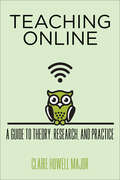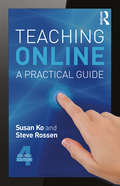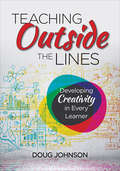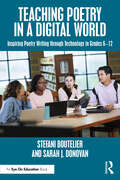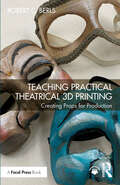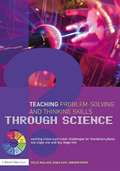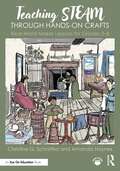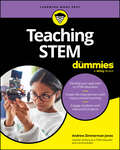- Table View
- List View
Teaching Generation Text
by Lisa Nielsen Willyn WebbMobilizing the power of cell phones to maximize students' learning power Teaching Generation Text shows how teachers can turn cell phones into an educational opportunity instead of an annoying distraction. With a host of innovative ideas, activities, lessons, and strategies, Nielsen and Webb offer a unique way to use students' preferred method of communication in the classroom. Cell phones can remind students to study, serve as a way to take notes, provide instant, on-demand answers and research, be a great vehicle for home-school connection, and record and capture oral reports or responses to polls and quizzes, all of which can be used to enhance lesson plans and increase motivation. Offers tactics for teachers to help their students integrate digital technology with their studies Filled with research-based ideas and strategies for using a cell phone to enhance learning Provides methods for incorporating cell phones into instruction with a unit planning guide and lesson plan ideas This innovative new book is filled with new ideas for engaging learners in fun, free, and easy ways using nothing more than a basic, text-enabled cell phone.
Teaching Geographic Information Science and Technology in Higher Education
by Kenneth Foote David Dibiase David Unwin Nicholas TateGeographic Information Science and Technology (GISc&T) has been at the forefront of education innovation in geography and allied sciences for two decades.Teaching Geographic Information Science and Technology in Higher Education is an invaluable reference for educators and researchers working in GISc&T, providing coverage of the latest innovations in the field and discussion of what the future holds for GI Science education in the years to come.This book clearly documents teaching innovations and takes stock of lessons learned from experience in the discipline. The content will be of interest both to educators and researchers working in GISc&T, and to educators in other related fields. More importantly, this book also anticipates some of the opportunities and challenges in GI Science and Technology education that may arise in the next decade. As such it will be of interest to chairs, deans, administrators, faculty in other subfields, and educators in general.Innovative book taking a look at recent innovations and teaching developments in the course provision of GI Science and Technology in higher education.Edited by leaders in the field of GISc&T who have been at the forefront of education innovation in GI Science and allied science subjects.Provides coverage of GISc & Technology in a range of institutional settings from an international perspective at all levels of higher education.An invaluable text for all educators within the field of GISc&T and allied subjects with advice from experts in the field on best practice.Includes coverage and practical advice on curriculum design, teaching with GIS technology, distance and eLearning with global examples from leading academics in the field.
Teaching Gifted Learners in STEM Subjects: Developing Talent in Science, Technology, Engineering and Mathematics (Routledge Research in Achievement and Gifted Education)
by Keith S. Taber Manabu Sumida Lynne McClureThis book offers an overview of programmes designed to support the learning of gifted and talented students in STEM subjects, both to allow them to meet their potential and to encourage them to proceed towards careers in STEM areas. The chapters from a range of national contexts report on perspectives, approaches and projects in gifted education in STEM subjects. These contributions provide a picture of the state of research and practice in this area, both to inform further research and development, and to support classroom teachers in their day-to-day work. Chapters have been written with practitioners in mind, but include relevant scholarly citations to the literature. The book includes some contributions illustrating research and practice in specific STEM areas, and others which bridge across different STEM subjects. The volume also includes an introductory theoretical chapter exploring the implications for gifted learners of how 'STEM' is understood and organized within the school curriculums.
Teaching High School Science Through Inquiry and Argumentation (2nd Edition)
by Douglas J. LlewellynProven ways to teach next generation science! To ensure our students achieve scientific literacy, we need to know what works in science teaching. One thing we know for certain: inquiry and argumentation are key. This groundbreaking book for Grades 9–12 addresses the new direction of science standards by emphasizing both inquiry-based and argument-based instruction. Filled with case studies and vignettes, this edition features: Exceptional coverage of scientific argumentation Enhanced chapters on assessment and classroom management Questioning techniques that promote the most learning Activities that emphasize making claims and citing evidence New examples of inquiry investigations New approaches to traditional labs
Teaching In Today's Inclusive Classrooms: A Universal Design For Learning Approach (Mindtap Course List)
by Richard GargiuloTEACHING IN TODAY'S INCLUSIVE CLASSROOMS: A UNIVERSAL DESIGN FOR LEARNING APPROACH, 3rd Edition is a concise, accessible, and current text for the Introduction to Inclusive Teaching course. It is the only inclusion textbook available with a consistent, integrated emphasis on Universal Design for Learning (UDL)�an important, contemporary educational philosophy focused on using strategies and tools to help ALL students by accommodating their differences. Aligned with InTASC and CEC standards, this text also provides foundational information about children with disabilities who are included in today's classrooms, and the most effective strategies for teaching them alongside their typically developing peers. Featuring new material on Common Core State Standards, case studies, and sound research-based teaching and learning strategies, this hands-on text offers you a practical, flexible framework for effective instruction, classroom management, assessment, and collaboration in today's diverse classrooms.
Teaching Information Seeking: Rethinking How We Teach Research in the Information Age
by Jon OstensonTeaching Information Seeking redefines how we approach research and information literacy in today's information-rich world, inviting teachers to re-imagine teaching research.The book combines insights from fields such as library and information sciences, journalism, and media literacy to offer fresh strategies and perspectives for guiding students through evolving landscapes of information.While a focus on concepts and skills has long been important in teaching research, this book integrates significant new understandings about the role dispositions play in how well students embrace and utilize skill-based knowledge. The book provides conceptual knowledge and learning activities that support writing teachers as they help students learn throughout the research or inquiry process of asking questions, finding information, and sharing their learning purposefully and ethically. Chapters with a pedagogical focus and approach include activities informed by the author’s decades of experience teaching writing. These activities are described in depth, including assignment prompts, sample work, and scripts for think-aloud protocols and discussions the author has led that engage students in deeper learning around these critical skills and dispositions. Teaching Information Seeking serves as a comprehensive guide for educators looking to foster meaningful information literacy and critical thinking skills in their students.This book is ideal for teachers and teacher educators who want to equip students with the skills and dispositions needed for effective research and information literacy. Readers will find teacher-friendly, research-grounded insights and activities that can be readily applied in the classroom.
Teaching Innovation in Architecture and Building Engineering: Challenges of the 21st century
by David Bienvenido-Huertas María Luisa de la Hoz-Torres Antonio Jesús Aguilar AguileraThis book presents contributions on teaching innovation in university architecture and building engineering studies. The authors explain how the construction sector demands that future architects and building engineers have the knowledge and skills that allow them to meet the decarbonization objectives established by international organizations and that this causes the level of knowledge to be higher. The contributors further discuss new technologies and the internationalization of studies presenting new challenges university studies must face. This heterogeneity is represented in the chapters that make up this book developed by researchers from different countries. The book is divided into three blocks: (i) Active learning methodologies; (ii) Innovative methodologies applied to learning process; and (iii) Traditional vs. Advanced Techniques. The chapters of the book represent an advance in the current knowledge of teaching innovation techniques in university architecture and building engineering studies.
Teaching Innovations in Economics: Towards a Sustainable World
by José–María Montero María del Carmen Valls MartínezThis book highlights the latest technological innovations in economics education. Economics, as a discipline, not only studies the relationship between ends and scarce means, which can be used alternatively, but also serves as a social science that uses historical data to predict future events—a task complicated by the influence of human behavior. In economics, a solid theoretical foundation alone is insufficient; practical application requires a deep understanding of statistics. With the vast amount of information available today, data processing is now performed using specialized software. Consequently, teaching economics demands a wide range of complex skills that have significantly evolved in recent years, driven by the growing interest in educational innovation among professors and scientists, further accelerated by advancements in new technologies. Moreover, economics education is increasingly aligned with the global concern for sustainability, as emphasized in the United Nations' Agenda 2030. Professors are now integrating sustainability into syllabi and teaching methodologies. This book covers key topics such as: Technological and innovative advancements in economics education. New teaching-learning theories and models in economics education. The impact of digital transformation on economics education. The role of artificial intelligence in economics education. Addressing special educational needs in economics education. Evaluation of the teaching-learning process in economics. Assessment of student learning in economics. Development of materials and tools for economics education. Final projects (Undergraduate and Master's) in economics. Authored by leading professors and researchers in the field, this book presents a collection of chapters that rigorously explore teaching innovations in economics.
Teaching Innovations in Lipid Science
by Randall J. WeselakeFeaturing practical strategies and exciting experiments, Teaching Innovations in Lipid Science addresses lipid education at a range of levels from the novice to the graduate student and teacher. Peer-reviewed contributions from internationally known specialists, describe several methods and approaches designed to create new lipid courses, mo
Teaching Language Online: A Guide for Designing, Developing, and Delivering Online, Blended, and Flipped Language Courses
by Victoria Russell Kathryn Murphy-JudyPractical and accessible, this book comprehensively covers everything you need to know to design, develop, and deliver successful online, blended, and flipped language courses. Grounded in the principles of instructional design and communicative language teaching, this book serves as a compendium of best practices, research, and strategies for creating learner-centered online language instruction that builds students’ proficiency within meaningful cultural contexts. This book addresses important topics such as finding and optimizing online resources and materials, learner engagement, teacher and student satisfaction and connectedness, professional development, and online language assessment. Teaching Language Online features: A step-by-step guide aligned with the American Council on the Teaching of Foreign Languages (ACTFL), the Common European Framework of Reference (CEFR) for Languages: Learning, Teaching and Assessment, and the World-Class Instructional Design and Assessment (WIDA) standards Research-based best practices and tools to implement effective communicative language teaching (CLT) online Strategies and practices that apply equally to world languages and ESL/EFL contexts Key takeaway summaries, discussion questions, and suggestions for further reading in every chapter Free, downloadable eResources with further readings and more materials available at www.routledge.com/ 9781138387003 As the demand for language courses in online or blended formats grows, K-16 instructors urgently need resources to effectively transition their teaching online. Designed to help world language instructors, professors, and K-12 language educators regardless of their level of experience with online learning, this book walks through the steps to move from the traditional classroom format to effective, successful online teaching environments.
Teaching Language and Teaching Literature in Virtual Environments
by María Luisa Carrió-PastorThis book sheds new light on language and literature teaching, and offers examples of teaching language in virtual environments. Providing an overview of virtual environments for teaching, it also includes chapters devoted to methodology design for second language teaching in these environments. Further it describes tools for second/ foreign language teaching and proposals for specific second language teaching in virtual environments. Lastly, it presents experiments on literature teaching in virtual environments and discusses the future of technology in education. With interdisciplinary appeal, the book is a particularly valuable resource for scholars with an interest in technology, language teaching and literature teaching.
Teaching Literature in Virtual Worlds: Immersive Learning in English Studies
by Allen WebbWhat are the realities and possibilities of utilizing on-line virtual worlds as teaching tools for specific literary works? Through engaging and surprising stories from classrooms where virtual worlds are in use, this book invites readers to understand and participate in this emerging and valuable pedagogy. It examines the experience of high school and college literature teachers involved in a pioneering project to develop virtual worlds for literary study, detailing how they created, utilized, and researched different immersive and interactive virtual reality environments to support the teaching of a wide range of literary works. Readers see how students role-play as literary characters, extending and altering character conduct in purposeful ways ,and how they explore on-line, interactive literature maps, museums, archives, and game worlds to analyze the impact of historical and cultural setting, language, and dialogue on literary characters and events. This book breaks exciting ground, offering insights, pedagogical suggestions, and ways for readers to consider the future of this innovative approach to teaching literary texts.
Teaching Literature with Digital Technology Assignments
by Tim HetlandTeaching Literature with Digital Technology is a collection of digital assignments, each created by a contributor in the fields of literature and composition. Edited by Seattle-based scholar and teacher Tim Hetland and available as a print text or PDF e-book, this resource for instructors invites students to become knowledge-makers as it introduces creative uses of social media, digital tools, podcasts, multimodal assignments, and digital archives to learn about literature. Sample assignments can be viewed in the Professional Resources folder on the Macmillan English Community site. To order the print text, use ISBN: 978-1-4576-2948-8; to order a PDF e-book of the text, use ISBN: 978-1-3190-7643-6.
Teaching Machines: Learning from the Intersection of Education and Technology (Tech.edu: A Hopkins Series on Education and Technology)
by Bill FersterTechnology promises to make learning better, cheaper, faster—but rarely has it kept that promise.The allure of educational technology is easy to understand. Classroom instruction is an expensive and time-consuming process fraught with contradictory theories and frustratingly uneven results. Educators, inspired by machines’ contributions to modern life, have been using technology to facilitate teaching for centuries.In Teaching Machines, Bill Ferster examines past attempts to automate instruction from the earliest use of the postal service for distance education to the current maelstrom surrounding Massive Open Online Courses. He tells the stories of the entrepreneurs and visionaries who, beginning in the colonial era, developed and promoted various instructional technologies. Ferster touches on a wide range of attempts to enhance the classroom experience with machines, from hornbooks, the Chautauqua movement, and correspondence courses to B. F. Skinner’s teaching machine, intelligent tutoring systems, and eLearning. The famed progressive teachers, researchers, and administrators that the book highlights often overcame substantial hurdles to implement their ideas, but not all of them succeeded in improving the quality of education. Teaching Machines provides invaluable new insight into our current debate over the efficacy of educational technology.
Teaching Machines: The History of Personalized Learning
by Audrey WattersHow ed tech was born: Twentieth-century teaching machines--from Sidney Pressey's mechanized test-giver to B. F. Skinner's behaviorist bell-ringing box.Contrary to popular belief, ed tech did not begin with videos on the internet. The idea of technology that would allow students to "go at their own pace" did not originate in Silicon Valley. In Teaching Machines, education writer Audrey Watters offers a lively history of predigital educational technology, from Sidney Pressey's mechanized positive-reinforcement provider to B. F. Skinner's behaviorist bell-ringing box. Watters shows that these machines and the pedagogy that accompanied them sprang from ideas--bite-sized content, individualized instruction--that had legs and were later picked up by textbook publishers and early advocates for computerized learning. Watters pays particular attention to the role of the media--newspapers, magazines, television, and film--in shaping people's perceptions of teaching machines as well as the psychological theories underpinning them. She considers these machines in the context of education reform, the political reverberations of Sputnik, and the rise of the testing and textbook industries. She chronicles Skinner's attempts to bring his teaching machines to market, culminating in the famous behaviorist's efforts to launch Didak 101, the "pre-verbal" machine that taught spelling. (Alternate names proposed by Skinner include "Autodidak," "Instructomat," and "Autostructor.") Telling these somewhat cautionary tales, Watters challenges what she calls "the teleology of ed tech"--the idea that not only is computerized education inevitable, but technological progress is the sole driver of events.
Teaching Mathematics Using Interactive Mapping
by Joseph J. Kerski Sandra L. Arlinghaus William C. ArlinghausTeaching Mathematics Using Interactive Mapping offers novel ways to learn basic math topics such as simple relational measures or measuring hierarchies through customized interactive mapping activities. These activities focus on interactive web-based Geographic Information System (GIS) and are relevant to today’s problems and challenges. Written in a guided, hands-on, understandable manner, all activities are designed to build practical and problem-solving skills that rest on mathematical principles and move students from thinking about maps as references that focus solely on "where is" something, to analytical tools, focusing primarily on the "whys of where." Success with this transition through interaction permits most readers to master mathematical concepts and GIS tools. FEATURES Offers custom-designed geographical activities to fit with specific mathematical topics Helps students become comfortable using mathematics in a variety of professions Provides an innovative, engaging, and practical set of activities to ease readers through typically difficult, often elementary, mathematical topics: fractions, the distributive law, and much more Uses web-based GIS maps, apps, and other tools and data that can be accessed on any device, anywhere, at any time, requiring no prior GIS background Written by experienced teachers and researchers with lifelong experience in teaching mathematics, geography, and spatial analysis This textbook applies to undergraduate and graduate students in universities and community colleges including those in basic mathematics courses, as well as upper-level undergraduate and graduate students taking courses in geographic information systems, remote sensing, photogrammetry, geography, geodesy, information science, engineering, and geology. Professionals interested in learning techniques and technologies for collecting, analyzing, managing, processing, and visualizing geospatial datasets will also benefit from this book as they refresh their knowledge in mathematics.
Teaching Online: A Guide to Theory, Research, and Practice (Tech.edu: A Hopkins Series on Education and Technology)
by Claire Howell MajorDemystifies online teaching for both enthusiastic and wary educators and helps faculty who teach online do their best work as digital instructors.It is difficult to imagine a college class today that does not include some online component—whether a simple posting of a syllabus to course management software, the use of social media for communication, or a full-blown course offering through a MOOC platform. In Teaching Online, Claire Howell Major describes for college faculty the changes that accompany use of such technologies and offers real-world strategies for surmounting digital teaching challenges.Teaching with these evolving media requires instructors to alter the ways in which they conceive of and do their work, according to Major. They must frequently update their knowledge of learning, teaching, and media, and they need to develop new forms of instruction, revise and reconceptualize classroom materials, and refresh their communication patterns. Faculty teaching online must also reconsider the student experience and determine what changes for students ultimately mean for their own work and for their institutions. Teaching Online presents instructors with a thoughtful synthesis of educational theory, research, and practice as well as a review of strategies for managing the instructional changes involved in teaching online. In addition, this book presents examples of best practices from successful online instructors as well as cutting-edge ideas from leading scholars and educational technologists. Faculty members, researchers, instructional designers, students, administrators, and policy makers who engage with online learning will find this book an invaluable resource.
Teaching Online: A Practical Guide (College Teaching Ser.)
by Susan Ko Steve RossenTeaching Online: A Practical Guide is an accessible, introductory, and comprehensive guide for anyone who teaches online. The fourth edition of this bestselling resource has been fully revised, maintains its reader-friendly tone, and offers exceptional practical advice, new teaching examples, faculty interviews, and an updated resource section. New to this edition: entire new chapter on MOOCs (massive open online courses); expanded information on teaching with mobile devices, using open educational resources, and learning analytics; additional interviews with faculty, case studies, and examples; spotlight on new tools and categories of tools, especially multimedia. Focusing on the "hows" and "whys" of implementation rather than theory, the fourth edition of Teaching Online is a must-have resource for anyone teaching online or thinking about teaching online.
Teaching Outside the Lines: Developing Creativity in Every Learner
by Douglas A. JohnsonMake Creativity The Center Of The Curriculum! In our fast-changing world, the ability to think independently and innovatively is no longer a “nice extra”—it’s a survival skill. This book delivers surefire strategies for equipping learners across all grades and subjects with the motivation and critical thinking skills to thrive in our high-tech future. Content includes: Why “one right answer” instruction paradigms discourage critical thinking and risk-taking Why merely using the latest technology class does not equate to teaching creatively Projects and prompts that ask the question “So what does this mean in the classroom today?”
Teaching Outside the Lines: Developing Creativity in Every Learner
by Douglas A. JohnsonMake Creativity The Center Of The Curriculum! In our fast-changing world, the ability to think independently and innovatively is no longer a “nice extra”—it’s a survival skill. This book delivers surefire strategies for equipping learners across all grades and subjects with the motivation and critical thinking skills to thrive in our high-tech future. Content includes: Why “one right answer” instruction paradigms discourage critical thinking and risk-taking Why merely using the latest technology class does not equate to teaching creatively Projects and prompts that ask the question “So what does this mean in the classroom today?”
Teaching Poetry in a Digital World: Inspiring Poetry Writing through Technology in Grades 6-12
by Stefani Boutelier Sarah J. DonovanTeaching Poetry in a Digital World supports English language arts (ELA) educators for grades 6–12 to incorporate digital literacy in their classrooms by teaching the reading and writing of poetry.In an increasingly digital age, educators must adapt to meet the changing needs and interests of their students by incorporating technology into the classroom. This book introduces its audience to the e-Poetry Framework. This framework demonstrates how poetry might present itself in a literacy-based unit with the benefit of a technology medium to share with the world. Examples include teaching zip-ode poetry, incorporating haiku with the creation of GIFs, and ethically discussing AI with nonet poems. With adaptable lesson plans and assessments, as well as educator examples, the book will inspire teachers to create intentional student-centered e-Poetry units.The book is aligned with ELA literacy standards, International Society for Technology in Education (ISTE) educator standards, and National Council of Teachers of English (NCTE)’s position statement for integrating technology into ELA classrooms. It is a key resource for secondary school educators teaching ELA, creative writing, and digital media.
Teaching Practical Theatrical 3D Printing: Creating Props for Production
by Robert C. BerlsTeaching Practical Theatrical 3D Printing: Creating Props for Production is a cohesive and practical guide for instructors teaching 3D printing techniques in stagecraft, costume and props courses.Written for the instructor, this book uses non-technical language to explain 3D printers, their workflows and products. Coverage includes the ins and outs of multiple filaments, pros and cons of different types of printers, shop or laboratory setup and safety concerns. The book features lesson plans, rubrics and class-tested sample student projects from design to finished product that highlight learning objectives and methodologies, as well as software and hardware usage explanations and common problems that can occur within design and printing. Step-by-step instructions are included for many types of projects, including fake noses, candlestick phones, buttons, 3D scans, historical recreations and linear actuators. The book also contains examples of poor, average and excellent work with grading explanations and guidance on how to help the student move to the next level with their projects. Chapter objectives, chapter summaries, checklists and reflection points facilitate an instructor in gaining confidence with 3D printers and incorporating their use in the classroom.Teaching Practical Theatrical 3D Printing is an excellent resource for instructors of Props and Costume Design and Construction courses that are interested in using state of the art tools and technology for theatre production.Fully editable files for every object featured in the book are available at www.routledge.com/9781032453279, allowing readers to jump-start their projects and giving them the flexibility to change and redesign the items to best fit their needs.
Teaching Problem-Solving and Thinking Skills through Science: Exciting Cross-Curricular Challenges for Foundation Phase, Key Stage One and Key Stage Two
by Andrew Berry Belle Wallace Diana CaveThis highly practical resource book presents ways in which teachers can help to develop children's problem-solving and thinking skills through a range of exciting science topics. The book contains classroom-based activities which have been trialled and evaluated by teachers and children, and helpfully shows how the skills developed through rigorous scientific investigations can be used across all areas of the curriculum. The scientific curriculum requirements are extended with exciting and inspiring problem-solving activities that use scientific skills, for example: fair-testing pattern-seeking surveying classifying and identifying investigations over time designing testing and adapting an artefact open-ended exploration The book contains learning objectives for each activity, step by step guidelines for carrying out each problem-solving activity, basic equipment that's needed, examples of learner's work and guidelines for assessment. This book is a must-buy for all early years and primary school teachers keen to encourage an inclusive but differentiated approach to the development of problem-solving and thinking skills in their pupils.
Teaching STEAM Through Hands-On Crafts: Real-World Maker Lessons for Grades 3-8
by Amanda Haynes Christine G. SchnittkaHelp your students connect historic technologies with today’s STEAM concepts through the lens of crafting! This book, written by a science education professor and a middle school STEM teacher, provides guidance for turning classic crafts into transdisciplinary STEAM lessons for grades 3–8. Ready-to-use lessons outline the history, science, mathematics, and engineering embedded within ten hands-on crafts from around the world. Each chapter outlines the history of a craft, its social impact, and the mathematics, engineering, and scientific concepts and skills embedded in the craft. Content standards from art, history, English language arts, technology, mathematics, and science are embedded within each unit. Lessons are supplemented with ready-to-photocopy handouts, guiding questions, and logistical support such as shopping lists and safety procedures. Activities have all been classroom-tested to ensure appropriate leveling and applicability across STEAM disciplines. Ideal for any STEM or STEAM classroom across upper elementary and middle schools, this book helps make STEM concepts meaningful and tangible for your students. Rather than just reading about science, technology, mathematics, or engineering, students will become makers and engage in STEAM directly, just as original crafters have done for centuries.Additional instructional materials are available at: https://steamcrafts.weebly.com/
Teaching STEM For Dummies
by Andrew Zimmerman JonesSpark a passion for STEM Teaching STEM For Dummies is an easy-to-read and exciting new guide for teachers who want to inspire their students with engaging lessons and thoughtful discussions about science, technology, engineering, and mathematics. This practical roadmap to developing hands-on classroom material relevant to the real world shows you how to define STEM topics and overcome the most common challenges to teaching these complex subjects to younger students. You'll learn how you can make STEM more welcoming—using inclusion, scaffolding, and differentiation—and discover resources for STEM teachers you can deploy immediately in your classroom. Inside the book: Understand the STEM concepts students are expected to learn at different grades and how to connect those ideas together in engaging lessons Teach your students the inquisitive mindsets, logical reasoning, and collaboration skills they'll need to succeed in STEM fields Increase STEM inclusivity in both the classroom and the industry by engaging all students in STEM from early ages Discover resources to educate students on the problem-solving concepts at the core of STEM subjects Perfect for teachers, homeschooling parents, tutors, and other educators, Teaching STEM For Dummies is a can't-miss read for anyone who wants to open young minds to the wonders of STEM.
